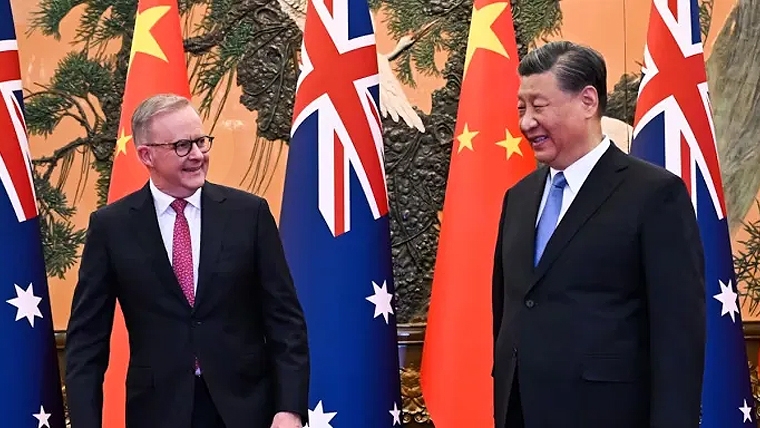
On the last full day of his 6-day trip to China, Australian Prime Minister Anthony Albanese visited the world’s largest panda breeding center in Chengdu. Admiring one of the pandas, the PM observed that ‘this guy is clearly feeling the friendship between China and Australia as well’.
That comment sums up the positive vibe of Albanese’s latest Chinese tour. On the face of it at least, the three-city tour – Beijing, Shanghai, and Chengdu – was a tremendous success.
It tops off an extended period of rebuilding Sino-Australian relations since they hit rock bottom five years ago. That was when then PM Scott Morrison called for an international investigation into the origins of Covid-19. Morrison’s call was quickly followed by China imposing trade bans on $20bn of Australian exports, and its Canberra embassy issuing a list of 14 Chinese grievances with Australia.
There was little sign of those grievances this week as Albanese was welcomed in grand style. He had meetings with President Xi Jinping, Premier Li Qiang, Chairman Zhao of the National People’s Congress, and many other senior officials.
Business and trade were a key focus of the PM’s trip. He was accompanied by a group of prominent Australian businesspeople, led by the Business Council of Australia, and he took part in the 8th Australia-China CEO roundtable.
Trade with China is fundamental to Australia’s economic success and the government’s finances. China is far and away Australia’s largest trading partner, with annual exports to China of $200bn. It’s been Australia’s biggest export market for the last 16 years and that looks unlikely to change any time soon. Mining, tourism, and education – three key sectors – are all major beneficiaries of the China relationship.
This was Albanese’s fourth meeting with President Xi in three years, and it included a private lunch also attended by Albanese’s fiancée, Jodie Haydon. Relations between the two leaders seemed very cordial. One commentator from the ABC went as far as to say, ‘it's increasingly clear that Chinese President Xi Jinping's preferred Western leader is Anthony Albanese’.
The reporting in the Chinese media was certainly positive. The headline in an editorial in The Global Times was ‘Looking forward to seeing China-Australia relations cruise steadily in the ‘stratosphere’’. It stated that ‘although China-Australia relations have experienced ups and downs, after the storm comes the rainbow.’
What a turnaround.
Nevertheless, there are still challenges to the relationship. The Albanese government wants to take back into Australian possession the Port of Darwin which is currently subject to a 99-year lease to a Chinese company unwilling to give up the port. Then there’s the case of Australian citizen Dr Yang Hengjun, a Chinese-Australian academic and businessman, who is held in a Chinese prison on spying charges.
But of course, the real elephant in the room is national security, and Australia’s relationship with the United States in particular. It was only a few months ago that Chinese warships were patrolling Australia’s coastline and carrying out ‘live fire’ exercises in the Tasman Sea.
And while Albanese was being wined and dined in China this week, Australia was hosting Exercise Talisman Sabre, a biennial joint exercise with the US. This was Australia’s largest ever military exercise involving 19 countries (including NZ) and 35,000 military personnel.
Fascinating timing
The US views China as its greatest military threat so it’s difficult to imagine that potential hostilities with China were not part of Exercise Talisman Sabre. Indeed, the Australian Defense Industry Minister said he expected that Chinese surveillance warships would monitor the exercise.
Australia’s security links with the US are comprehensive, including ANZUS, the Five Eyes alliance, the Quadrilateral Security Dialogue, and AUKUS. The latter involves Australia investing $368bn in US nuclear submarines.
There’s also Pine Gap (the top-secret US-Australian satellite communications and signals intelligence facility in the Northern Territory), US troops based in Darwin and Tindal in the Northern Territory, and the proposed rotation of US submarines at a base in Western Australia from 2027.
All this leaves Australia in something of a dilemma. On the one hand China, its crucial trading partner. On the other America, its vital security partner. And growing tension between the two, primarily over Taiwan.
The dilemma was highlighted during Albanese’s trip to China by reports in The Financial Times that the US has asked Australia and Japan what they would do if the US went to war with China over Taiwan. Unsurprisingly, Albanese was quizzed about this by journalists in China. While avoiding a direct response, he did say Australia supports ‘the status quo’ and doesn’t support ‘any unilateral action’.
The difficulty of Albanese’s balancing act is compounded by the unpredictability of the Trump presidency. For the first time in decades US allies are questioning the reliability of America as the defender of democracy and the post-WWII liberal international order.
What does ‘America First’ mean for Australia? Why is Australia’s key security ally imposing tariffs on Australian exports? Could the erratic Donald Trump drag Australia into an unwanted war?
China is all too aware of Australia’s dilemma. It’s keen to portray itself as the calm, sensible superpower, and Trump’s America as the loose cannon. This was reflected in The Global Times editorial that described Australia and China as ‘both beneficiaries and defenders of the post-war international order’ who want to ‘inject more stability and certainty into a world undergoing turbulence and change’.
It's unlikely Prime Minister Albanese sees Sino-Australian relations in exactly those terms. Nevertheless, he appears determined to minimise friction with his country’s key trading partner.
Perhaps the best summary of the ‘Albanese doctrine’ came on his visit to the Great Wall of China
I’ve said consistently that we’ll cooperate where we can, disagree where we must, but engage in our national interest. It is very clear that it is in our national interest for us to have a positive relationship with China. Where there are differences, we’ll talk about them, but not be defined by them.
Not a bad doctrine in a very challenging situation.
There’s a risk that by pursuing friendly relations with China, Albanese will attract the ire of President Trump or one of his hardline subordinates. Both Vice President JD Vance and Secretary of State Marco Rubio have been critical of China.
Interestingly, Albanese has not yet had a meeting with the US president since he was re-elected PM in May. Some have interpreted that as a sign Albanese has his priorities wrong.
But perhaps he’s just nervous about facing Trump, Vance, and Rubio in the Oval Office hot seat.
*Ross Stitt is a freelance writer with a PhD in political science. He is a New Zealander based in Sydney. His articles are part of our 'Understanding Australia' series.

We welcome your comments below. If you are not already registered, please register to comment.
Remember we welcome robust, respectful and insightful debate. We don't welcome abusive or defamatory comments and will de-register those repeatedly making such comments. Our current comment policy is here.